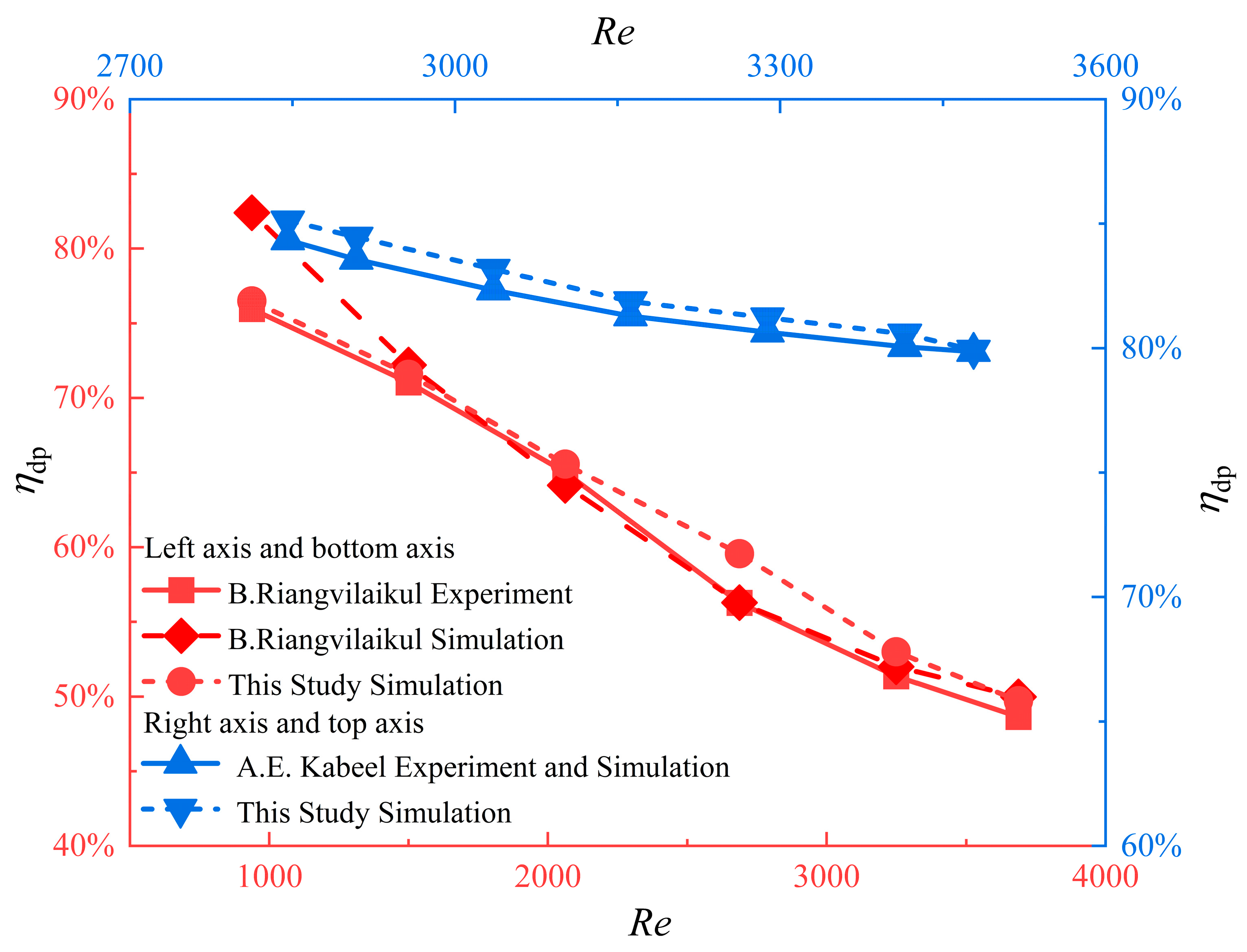Numerical Analysis on Performance Improvement of a Vertical Plate Indirect Evaporative Cooler with Baffles
Abstract
1. Introduction
2. Vertical PIEC and Its Principle
3. Numerical Model and Methods
3.1. Physical Model
3.2. Numerical Model and Method
3.2.1. Prerequisite Assumptions
- (1)
- The heat and mass transfer process are stable.
- (2)
- In channels, the properties of water film and air are considered to be stable, uniform, and incompressible, and the mixture of air and water vapor is considered to be an ideal gas.
- (3)
- The PIEC does not exchange heat and mass with the surroundings.
- (4)
- The effects of droplet splash, separation, collection, breakup, contact angle, and sharp angles of water film are neglected.
- (5)
- The circulating water forms a stable and uniform water film on the inner surface of the wet channel, and the maximum water film thickness is 5 mm.
- (6)
- This numerical model is only used for the PIEC in dry areas, regardless of condensation.
3.2.2. Numerical Method and Boundaries
3.2.3. Numerical Model Equations
3.2.4. Evaluation Index
3.3. Mesh Generation and Independence Assessment
3.4. Validation of Numerical Model and Method
4. Results and Discussion
4.1. Baffle Length Influence
4.2. Parameter Influence of Inlet Air
4.3. Channel Size Influence
5. Conclusions
- (1)
- The numerical model and method proposed in this study is simpler and effective. The method obviates the need for an empirical estimation of Lewis number in simulations, and only necessitates a high-quality mesh in the water film region. The maximum deviation between the simulation results obtained using the numerical simulation method proposed in this study and the experimental and simulation results reported in the references is below 10%.
- (2)
- The baffle effect on PIEC performance is dependent on the baffle length, the channel size, and the inlet air parameters. A relative length of 60% is recommended in this research. The baffle can significantly enhance the wet bulb efficiency of PIECs by up to 22.8–29.3%.
- (3)
- Although the baffle effect on PIEC performance is positive, the additional resistance induced by the baffle is not neglected, and so, the comprehensive performance evaluation index is needed. When the channel length is shorter and the width is wider, the comprehensive evaluation coefficient can significantly increase up to 1.88. When the Lb/L exceeds 60% and the primary air velocity exceeds 4 m/s, the comprehensive performance evaluation index will be less than 1 due to the excessive pressure loss, which is detrimental to PIEC performance.
Author Contributions
Funding
Data Availability Statement
Conflicts of Interest
References
- Jing, Y.; Xie, X.; Jiang, Y. Performance comparison and suitable climatic zones of three water-mediated evaporative cooling technologies. Energy Convers. Manag. 2023, 277, 116637. [Google Scholar] [CrossRef]
- Jamil, M.A.; Imtiaz, N.; Ng, K.C.; Xu, B.B.; Yaqoob, H.; Sultan, M.; Shahzad, M.W. Experimental and parametric sensitivity analysis of a novel indirect evaporative cooler for greener cooling. Therm. Sci. Eng. Prog. 2023, 42, 101887. [Google Scholar] [CrossRef]
- Pacak, A.; Worek, W. Review of Dew Point Evaporative Cooling Technology for Air Conditioning Applications. Appl. Sci. 2021, 11, 934. [Google Scholar] [CrossRef]
- Shukla, D.L.; Modi, K.V. Influence of distinct input parameters on performance indices of dehumidifier, regenerator and on liquid desiccant-operated evaporative cooling system—A critical review. Renew. Sustain. Energy Rev. 2022, 168, 112834. [Google Scholar] [CrossRef]
- Mohammed, R.H.; El-Morsi, M.; Abdelaziz, O. Indirect evaporative cooling for buildings: A comprehensive patents review. J. Build. Eng. 2022, 50, 104158. [Google Scholar] [CrossRef]
- Zhao, C.-Y.; Liang, L.-W.; Qi, D.; Ji, W.-T.; Tao, W.-Q. The effect of gas streams on the hydrodynamics, heat and mass transfer in falling film evaporation, absorption, cooling and dehumidification: A comprehensive review. Build. Environ. 2022, 219, 109183. [Google Scholar] [CrossRef]
- Chen, Y.; Yan, H.; Min, Y. Visualized study of wetting enhancement and thermal performance of fiber-coated indirect evaporative cooler. Appl. Therm. Eng. 2023, 221, 119904. [Google Scholar] [CrossRef]
- Zhu, G.; Chen, W.; Zhang, D.; Wen, T. Performance evaluation of counter flow dew-point evaporative cooler with a three-dimensional numerical model. Appl. Therm. Eng. 2023, 219, 119483. [Google Scholar] [CrossRef]
- Zhu, G.; Wen, T.; Wang, Q.; Xu, X. A review of dew-point evaporative cooling: Recent advances and future development. Appl. Energy 2022, 312, 118785. [Google Scholar] [CrossRef]
- Pacak, A.; Jurga, A.; Kaźmierczak, B.; Pandelidis, D. Experimental verification of the effect of air pre-cooling in dew point evaporative cooler on the performance of a solid desiccant dehumidifier. Int. Commun. Heat Mass Transf. 2023, 142, 106651. [Google Scholar] [CrossRef]
- Cui, X.; Chua, K.J.; Islam, M.R.; Ng, K.C. Performance evaluation of an indirect pre-cooling evaporative heat exchanger operating in hot and humid climate. Energy Convers. Manag. 2015, 102, 140–150. [Google Scholar] [CrossRef]
- Wan, Y.; Huang, Z.; Soh, A.; Jon Chua, K. On the performance study of a hybrid indirect evaporative cooling and latent-heat thermal energy storage system under commercial operating conditions. Appl. Therm. Eng. 2023, 221, 119902. [Google Scholar] [CrossRef]
- Chakraborty, S.; Vernon, D.; Jha, A.; Narayanan, V. Performance characterization of M-cycle indirect evaporative cooler and heat recovery ventilator for commercial buildings—Experiments and model. Energy Build. 2023, 281, 112762. [Google Scholar] [CrossRef]
- Kabeel, A.E.; Bassuoni, M.M.; Abdelgaied, M. Experimental study of a novel integrated system of indirect evaporative cooler with internal baffles and evaporative condenser. Energy Convers. Manag. 2017, 138, 518–525. [Google Scholar] [CrossRef]
- Moshari, S.; Heidarinejad, G.; Fathipour, A. Numerical investigation of wet-bulb effectiveness and water consumption in one-and two-stage indirect evaporative coolers. Energy Convers. Manag. 2016, 108, 309–321. [Google Scholar] [CrossRef]
- Yang, H.; Shi, W.; Chen, Y.; Min, Y. Research development of indirect evaporative cooling technology: An updated review. Renew. Sustain. Energy Rev. 2021, 145, 111082. [Google Scholar] [CrossRef]
- Abdullah, S.; Zubir, M.N.B.M.; Muhamad, M.R.B.; Newaz, K.M.S.; Öztop, H.F.; Alam, M.S.; Shaikh, K. Technological development of evaporative cooling systems and its integration with air dehumidification processes: A review. Energy Build. 2023, 283, 112805. [Google Scholar] [CrossRef]
- Min, Y.; Chen, Y.; Yang, H. Investigation on dynamic behaviour of condensation heat transfer in indirective evaporative cooler. Indoor Built Environ. 2020, 31, 2024–2035. [Google Scholar] [CrossRef]
- Yang, Y.; Cui, G.; Lan, C.Q. Developments in evaporative cooling and enhanced evaporative cooling—A review. Renew. Sustain. Energy Rev. 2019, 113, 109230. [Google Scholar] [CrossRef]
- Lee, J.; Choi, B.; Lee, D.-Y. Comparison of configurations for a compact regenerative evaporative cooler. Int. J. Heat Mass Transf. 2013, 65, 192–198. [Google Scholar] [CrossRef]
- Lee, J.; Lee, D.-Y. Experimental study of a counter flow regenerative evaporative cooler with finned channels. Int. J. Heat Mass Transf. 2013, 65, 173–179. [Google Scholar] [CrossRef]
- Duan, Z.; Zhan, C.; Zhao, X.; Dong, X. Experimental study of a counter-flow regenerative evaporative cooler. Build. Environ. 2016, 104, 47–58. [Google Scholar] [CrossRef]
- Liu, Y.; Akhlaghi, Y.G.; Zhao, X.; Li, J. Experimental and numerical investigation of a high-efficiency dew-point evaporative cooler. Energy Build. 2019, 197, 120–130. [Google Scholar] [CrossRef]
- Ali, M.; Ahmad, W.; Sheikh, N.A.; Ali, H.; Kousar, R.; ur Rashid, T. Performance enhancement of a cross flow dew point indirect evaporative cooler with circular finned channel geometry. J. Build. Eng. 2021, 35, 101980. [Google Scholar] [CrossRef]
- Kabeel, A.E.; Abdelgaied, M. Numerical and experimental investigation of a novel configuration of indirect evaporative cooler with internal baffles. Energy Convers. Manag. 2016, 126, 526–536. [Google Scholar] [CrossRef]
- Moshari, S.; Heidarinejad, G. Analytical estimation of pressure drop in indirect evaporative coolers for power reduction. Energy Build. 2017, 150, 149–162. [Google Scholar] [CrossRef]
- Cui, X.; Chua, K.J.; Islam, M.R.; Yang, W.M. Fundamental formulation of a modified LMTD method to study indirect evaporative heat exchangers. Energy Convers. Manag. 2014, 88, 372–381. [Google Scholar] [CrossRef]
- Anisimov, S.; Pandelidis, D.; Jedlikowski, A.; Polushkin, V. Performance investigation of a M (Maisotsenko)-cycle cross-flow heat exchanger used for indirect evaporative cooling. Energy 2014, 76, 593–606. [Google Scholar] [CrossRef]
- Chen, Y.; Yang, H.; Luo, Y. Indirect evaporative cooler considering condensation from primary air: Model development and parameter analysis. Build. Environ. 2016, 95, 330–345. [Google Scholar] [CrossRef]
- Sadighi Dizaji, H.; Hu, E.J.; Chen, L.; Pourhedayat, S. Analytical/experimental sensitivity study of key design and operational parameters of perforated Maisotsenko cooler based on novel wet-surface theory. Appl. Energy 2020, 262, 114557. [Google Scholar] [CrossRef]
- Wan, Y.; Ren, C.; Wang, Z.; Yang, Y.; Yu, L. Numerical study and performance correlation development on counter-flow indirect evaporative air coolers. Int. J. Heat Mass Transf. 2017, 115, 826–830. [Google Scholar] [CrossRef]
- Li, R.; Zhou, W.; Wu, J.; Li, J.; Dong, X.; Zhao, J. Numerical method and analysis of a tube indirect evaporative cooler. Therm. Sci. 2022, 26, 375–387. [Google Scholar] [CrossRef]
- Cui, X.; Chua, K.J.; Yang, W.M. Numerical simulation of a novel energy-efficient dew-point evaporative air cooler. Appl. Energy 2014, 136, 979–988. [Google Scholar] [CrossRef]
- Wan, Y.; Huang, Z.; Soh, A.; Cui, X.; Chua, K.J. Analysing the transport phenomena of novel dew-point evaporative coolers with different flow configurations considering condensation. Int. J. Heat Mass Transf. 2021, 170, 120991. [Google Scholar] [CrossRef]
- Wan, Y.; Lin, J.; Chua, K.J.; Ren, C. Similarity analysis and comparative study on the performance of counter-flow dew point evaporative coolers with experimental validation. Energy Convers. Manag. 2018, 169, 97–110. [Google Scholar] [CrossRef]
- Wan, Y.; Soh, A.; Shao, Y.; Cui, X.; Tang, Y.; Chua, K.J. Numerical study and correlations for heat and mass transfer coefficients in indirect evaporative coolers with condensation based on orthogonal test and CFD approach. Int. J. Heat Mass Transf. 2020, 153, 119580. [Google Scholar] [CrossRef]
- Gao, F.; Thu, K.; Wang, S.; Zhao, F.; Lin, J.; Wu, K. Numerical investigation of a novel tubular dew-point evaporative cooler. Appl. Therm. Eng. 2023, 223, 120064. [Google Scholar] [CrossRef]
- Ansys Fluent Theory Guide; ANSYS, Inc.: Canonsburg, PA, USA,, 2021.
- Shi, W.; Liu, T.; Song, K.; Zhang, Q.; Hu, W.; Wang, L. The optimal longitudinal location of curved winglets for better thermal performance of a finned-tube heat exchanger. Int. J. Therm. Sci. 2021, 167, 107035. [Google Scholar] [CrossRef]
- Riangvilaikul, B.; Kumar, S. An experimental study of a novel dew point evaporative cooling system. Energy Build. 2010, 42, 637–644. [Google Scholar] [CrossRef]
- Riangvilaikul, B.; Kumar, S. Numerical study of a novel dew point evaporative cooling system. Energy Build. 2010, 42, 2241–2250. [Google Scholar] [CrossRef]
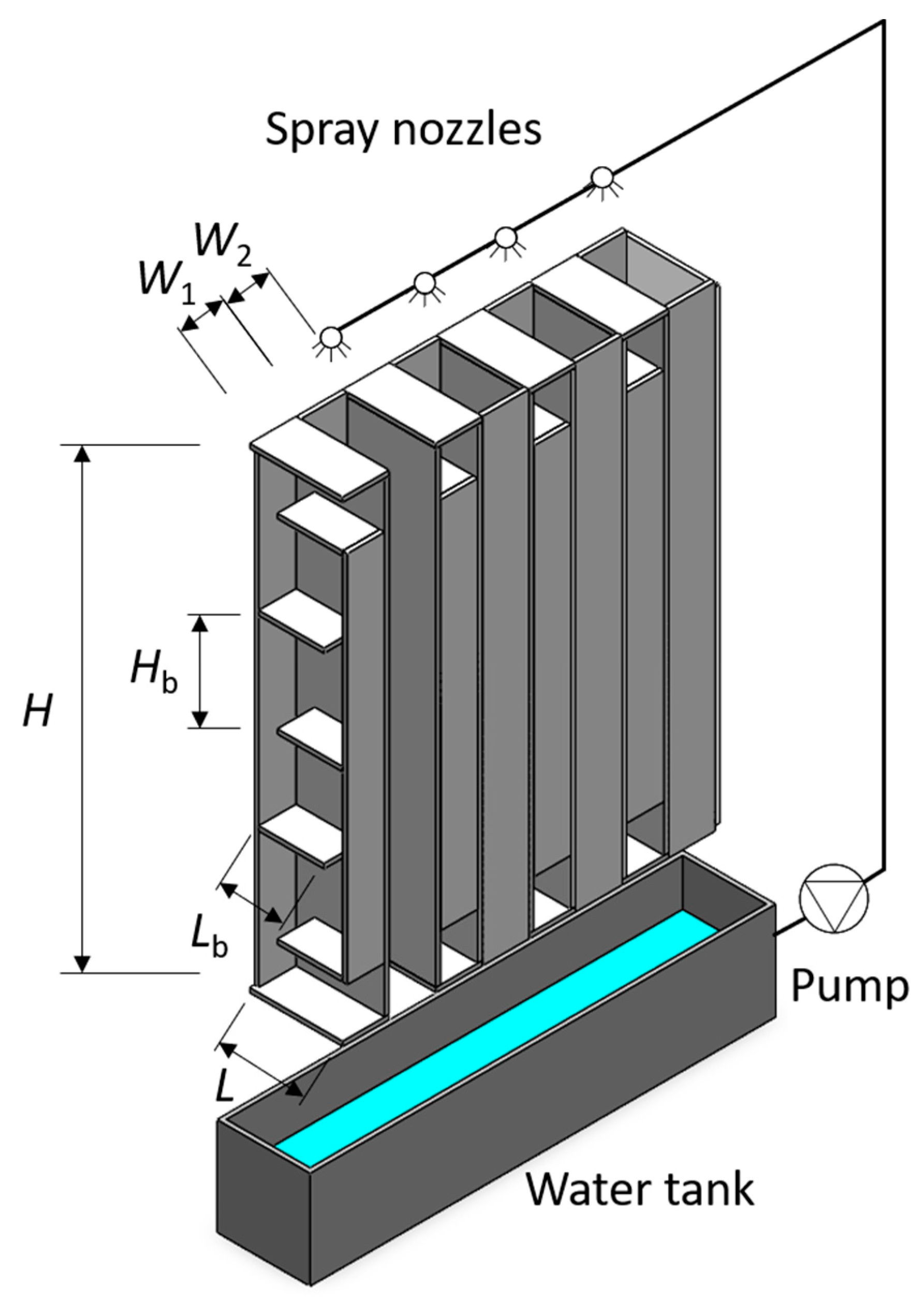

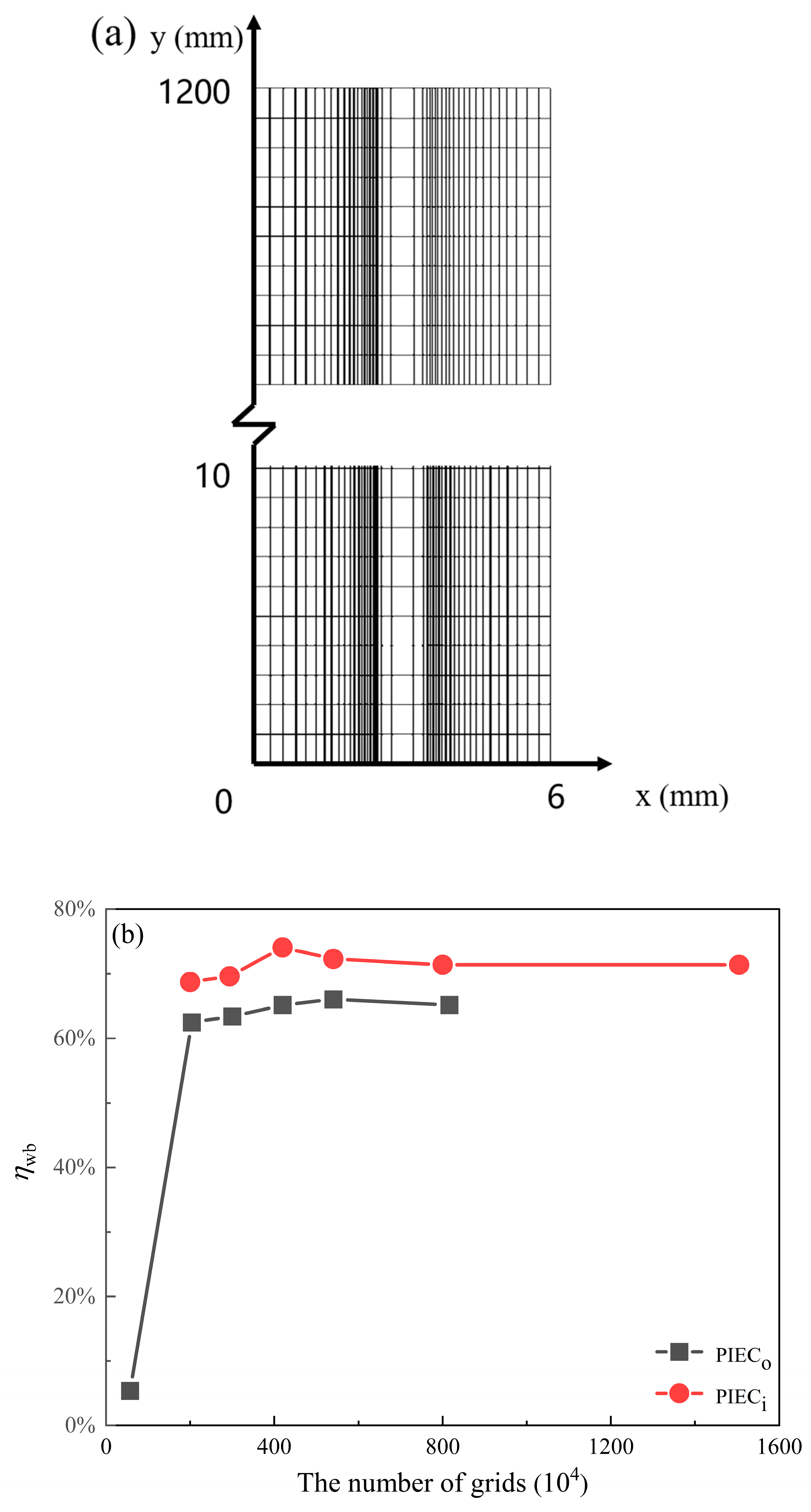
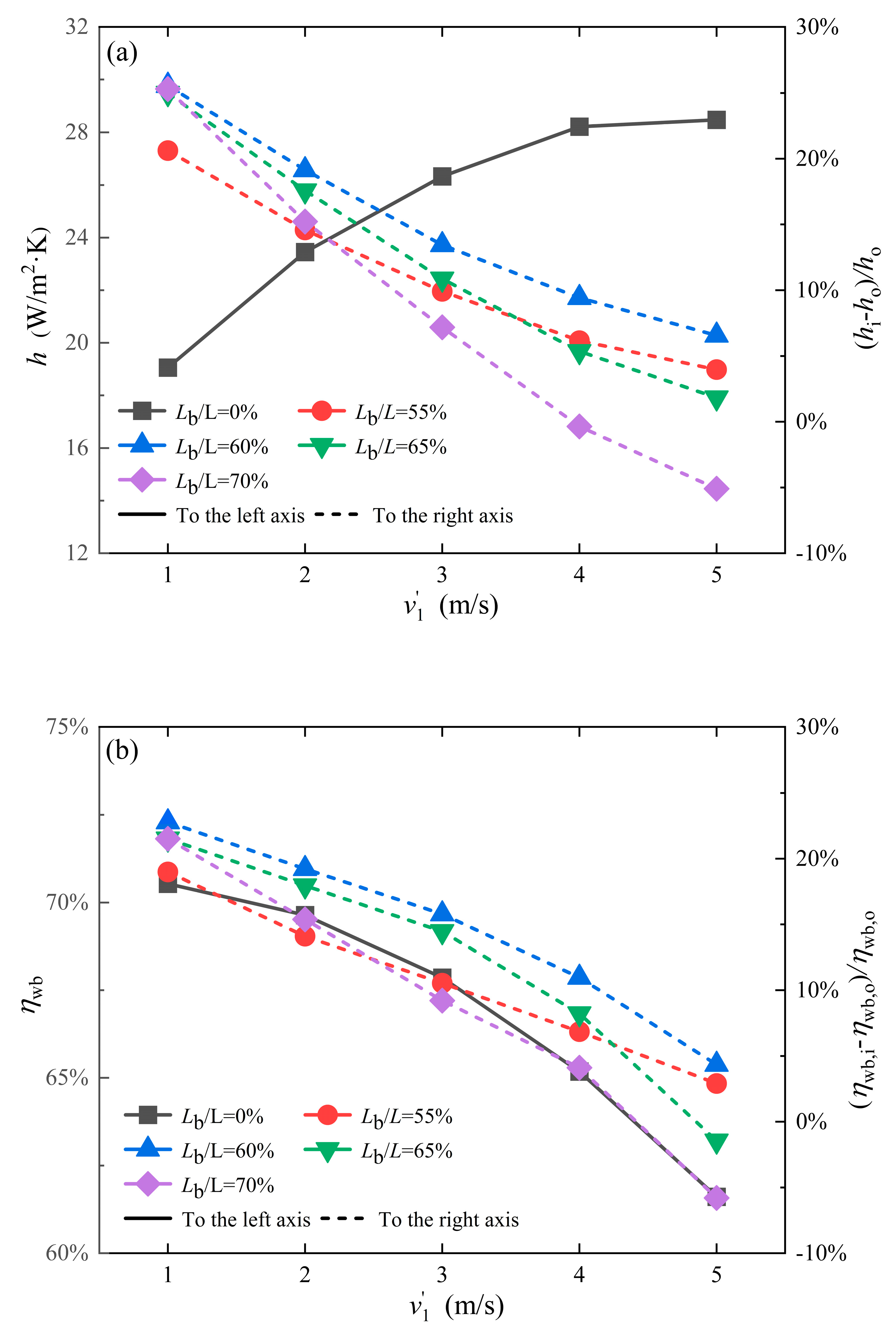
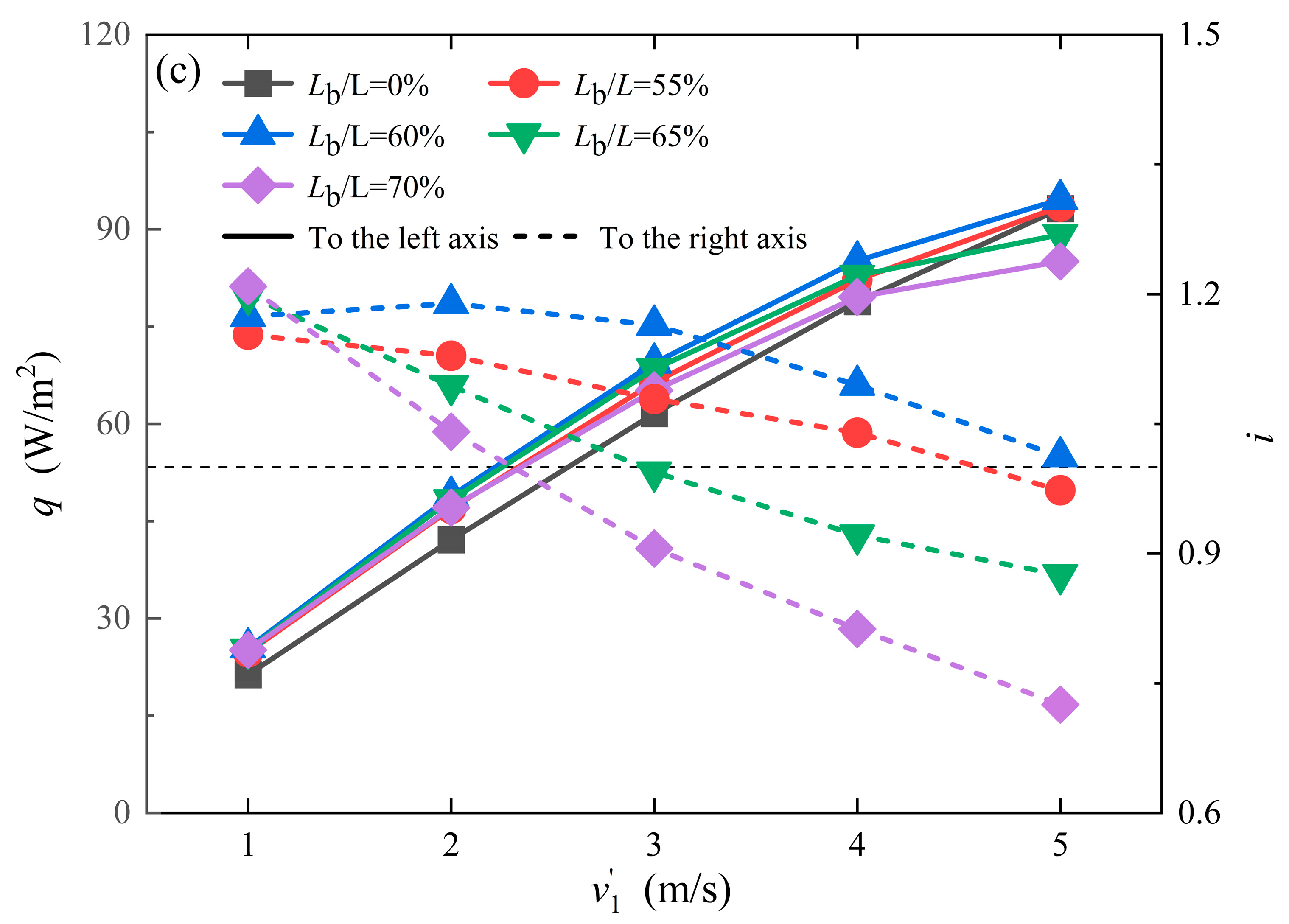
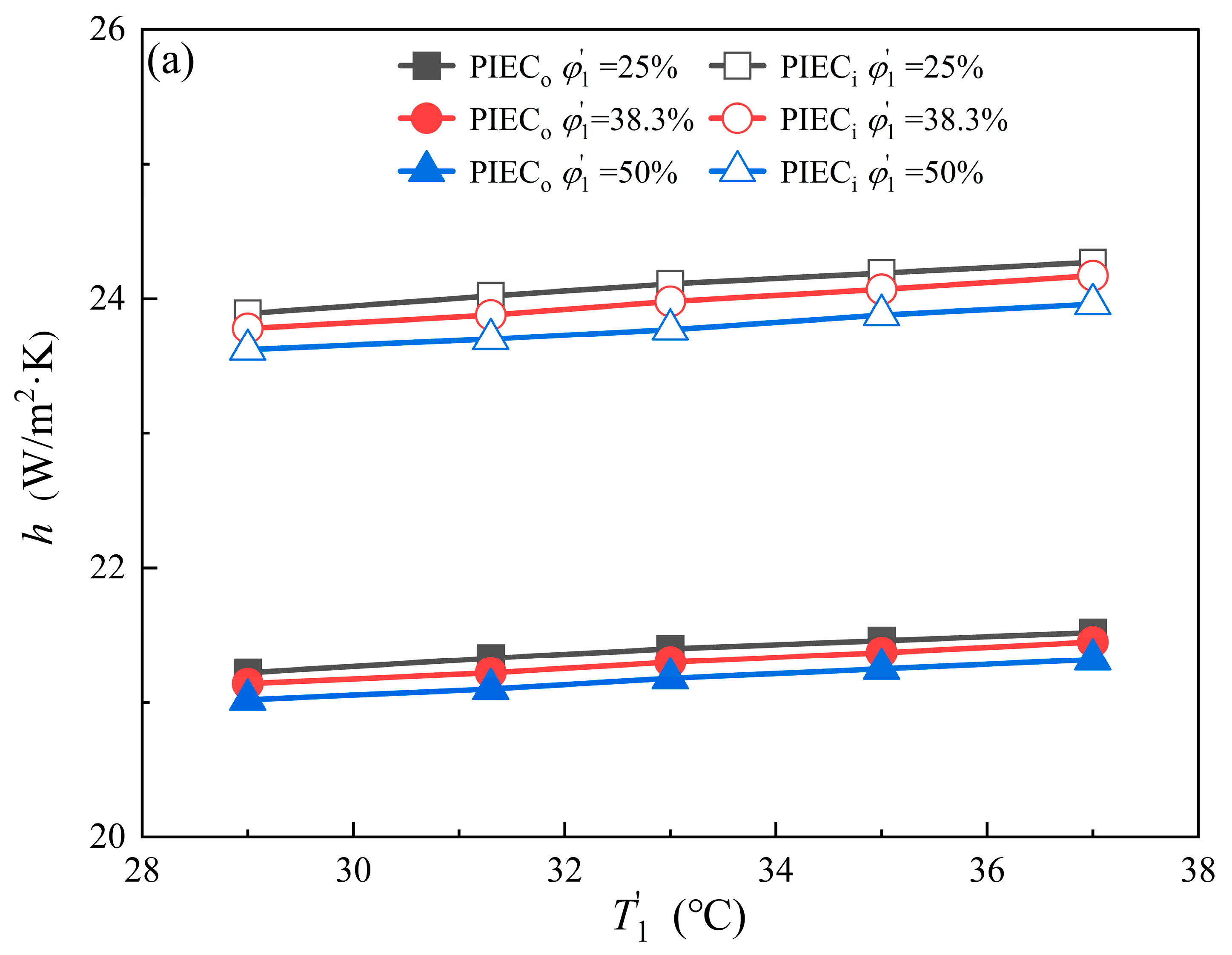
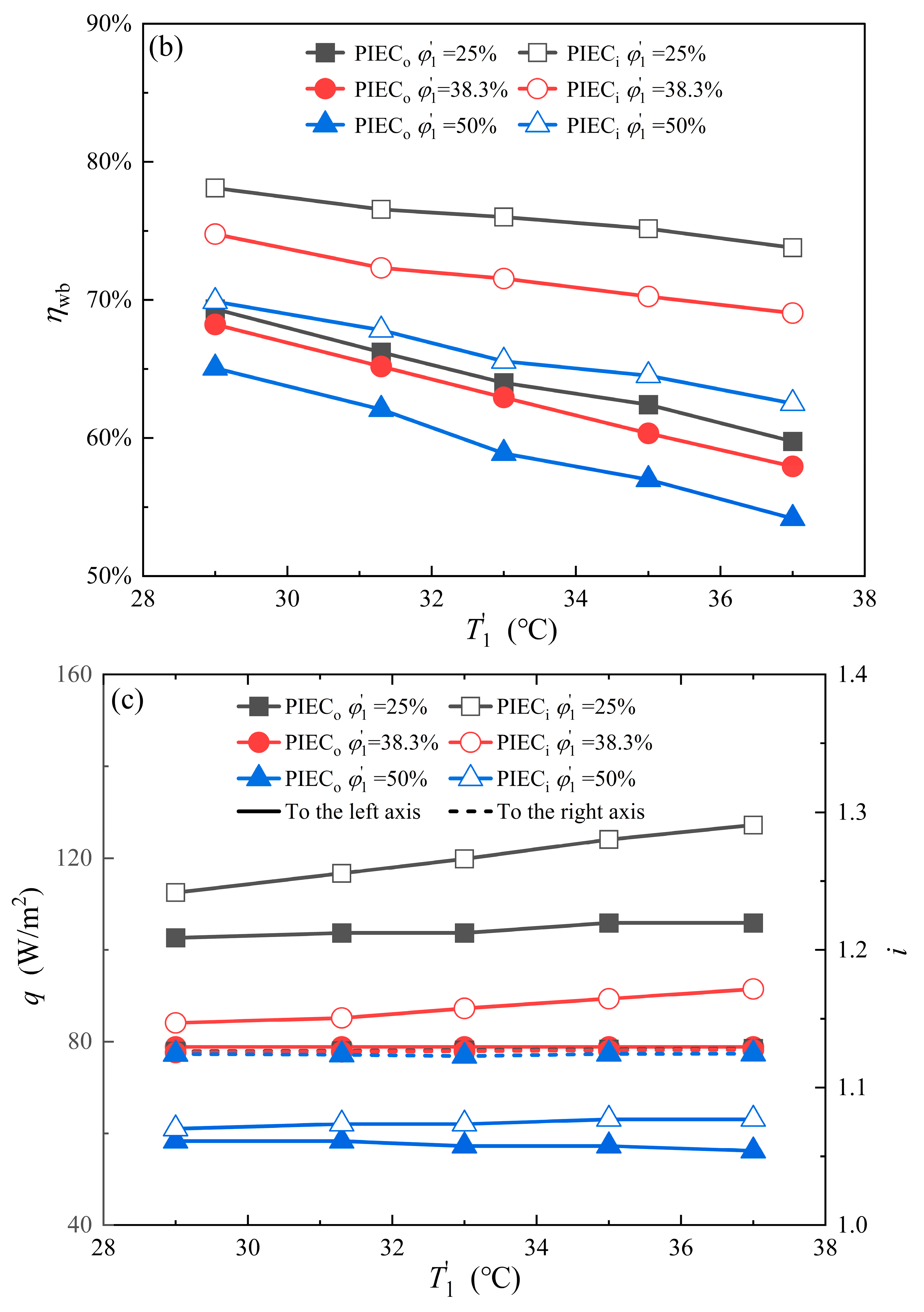
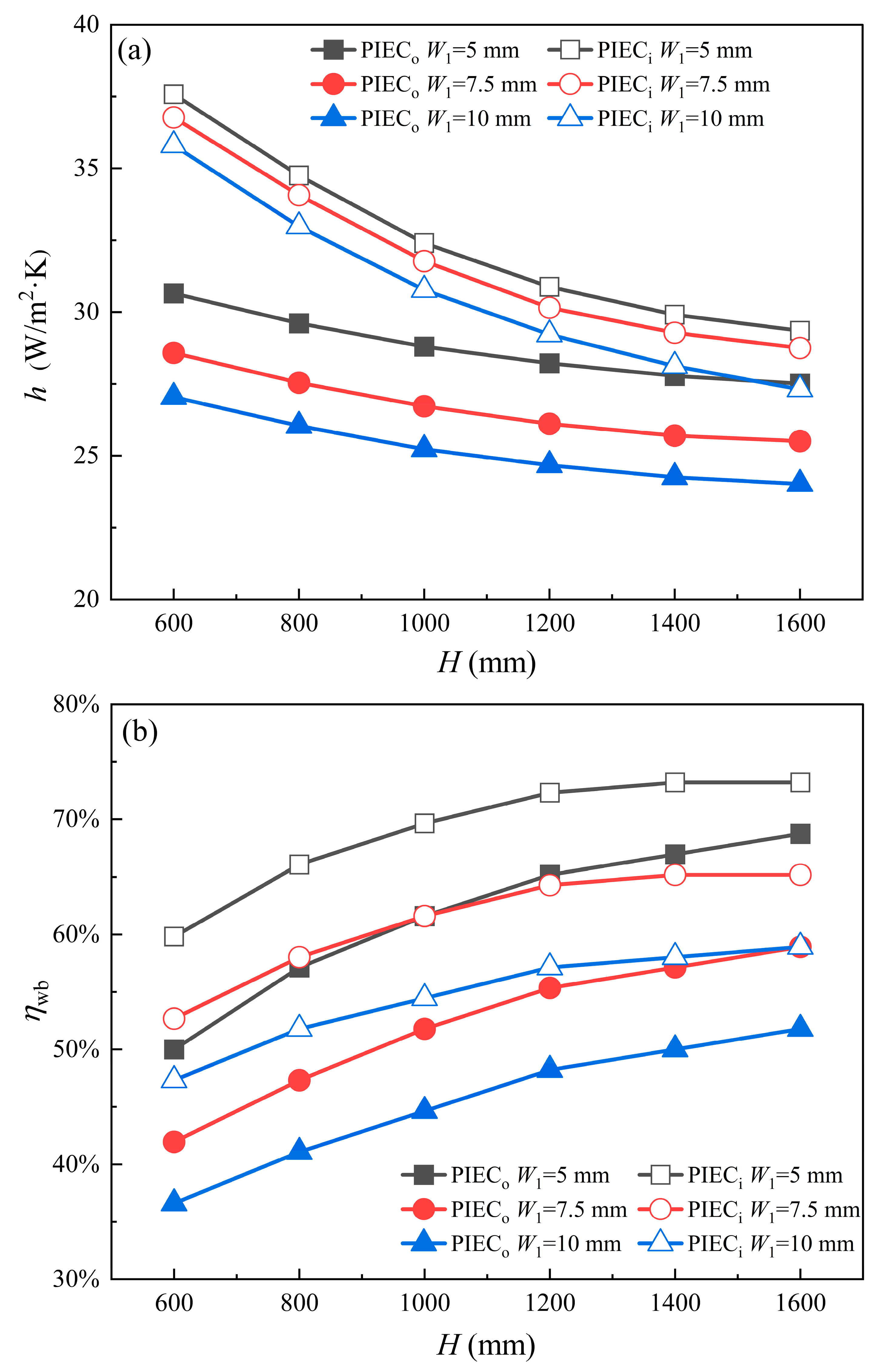
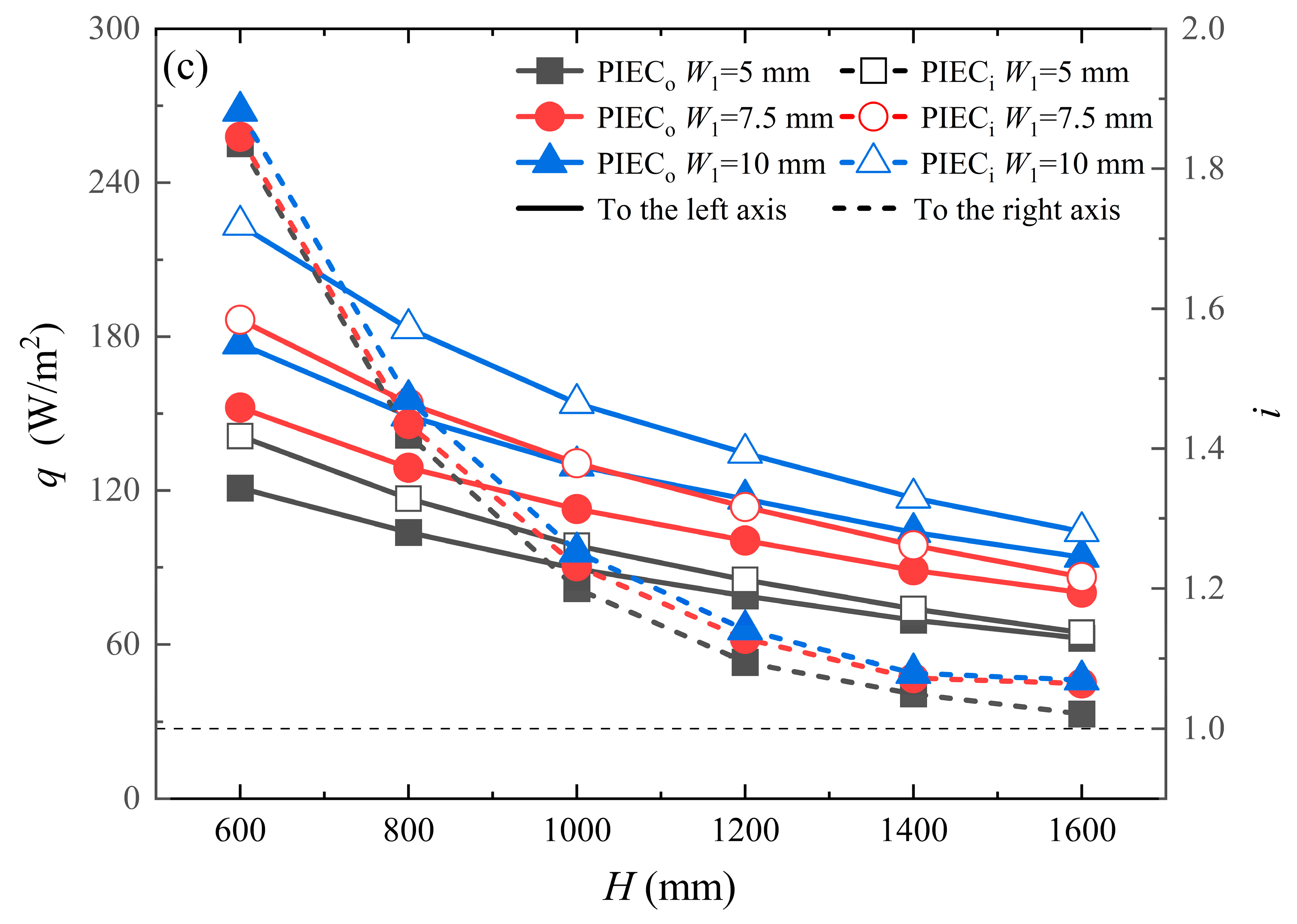
| Parameters | Value | Parameters | Value |
|---|---|---|---|
| H | 1200 mm | Lb | 60 mm |
| L | 100 mm | W1 | 5 mm |
| Hb | 100 mm | W2 | 5 mm |
| Operating Condition | Symbol | Default Values |
|---|---|---|
| Primary and secondary air temperature | T1, T2 | 31.3 °C |
| Primary and secondary air relative humidity | φ1, φ2 | 38.3% |
| Primary and secondary air density | ρ1, ρ2 | 0.956 kg/m3 |
| Primary air velocity | v1 | 4 m/s |
| Secondary air velocity | v2 | 4 m/s |
| Circulating water mass flow rate | 0.014 kg/m2·s |
Disclaimer/Publisher’s Note: The statements, opinions and data contained in all publications are solely those of the individual author(s) and contributor(s) and not of MDPI and/or the editor(s). MDPI and/or the editor(s) disclaim responsibility for any injury to people or property resulting from any ideas, methods, instructions or products referred to in the content. |
© 2024 by the authors. Licensee MDPI, Basel, Switzerland. This article is an open access article distributed under the terms and conditions of the Creative Commons Attribution (CC BY) license (https://creativecommons.org/licenses/by/4.0/).
Share and Cite
Zhou, W.; Cheng, S.; Wang, J.; Liu, Y. Numerical Analysis on Performance Improvement of a Vertical Plate Indirect Evaporative Cooler with Baffles. Energies 2024, 17, 2315. https://doi.org/10.3390/en17102315
Zhou W, Cheng S, Wang J, Liu Y. Numerical Analysis on Performance Improvement of a Vertical Plate Indirect Evaporative Cooler with Baffles. Energies. 2024; 17(10):2315. https://doi.org/10.3390/en17102315
Chicago/Turabian StyleZhou, Wenhe, Shuo Cheng, Jia Wang, and Yong Liu. 2024. "Numerical Analysis on Performance Improvement of a Vertical Plate Indirect Evaporative Cooler with Baffles" Energies 17, no. 10: 2315. https://doi.org/10.3390/en17102315
APA StyleZhou, W., Cheng, S., Wang, J., & Liu, Y. (2024). Numerical Analysis on Performance Improvement of a Vertical Plate Indirect Evaporative Cooler with Baffles. Energies, 17(10), 2315. https://doi.org/10.3390/en17102315




